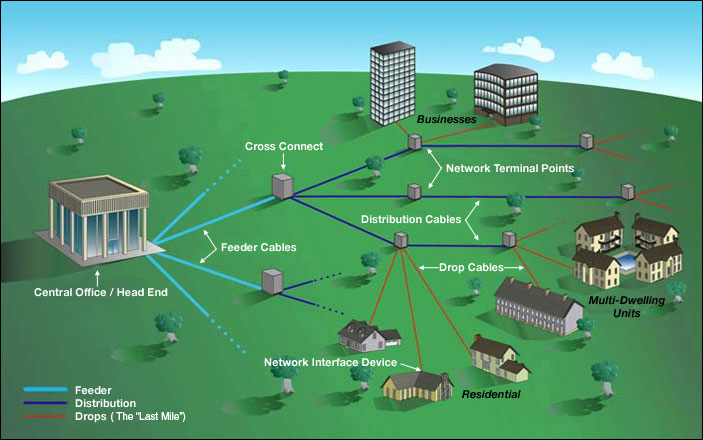
DigitalBridge and Crestview Partners Buy Internet Provider WideOpenWest for $1.5 Billion
The Digital Infrastructure Gold Rush: WideOpenWest's $1.5 Billion Private Exit Signals New Era
ENGLEWOOD, Colorado — WideOpenWest announced Monday that DigitalBridge Group and Crestview Partners will acquire the regional broadband provider in a $1.5 billion all-cash transaction, paying $5.20 per share to take the company private.
The deal represents a 63% premium over WideOpenWest's closing price on Friday and a 37% premium over the stock's unaffected price before initial buyout discussions began in May 2024. Crestview Partners, already WideOpenWest's largest shareholder with a 37% stake, will roll over its existing shares rather than cash out
The transaction removes another mid-sized telecommunications company from public markets as private equity firms increasingly target infrastructure assets requiring long-term capital investments that public shareholders have been reluctant to support.
The Arithmetic of Abandonment
The mathematics underlying Monday's transaction reveal the stark realities facing mid-tier broadband providers. Trading at approximately 5.0 times trailing EBITDA, WideOpenWest's valuation reflects neither the premium multiples commanded by infrastructure giants nor the growth expectations typically associated with digital platforms.
EBITDA, or Earnings Before Interest, Taxes, Depreciation, and Amortization, is a measure of a company's core operational profitability, used as a proxy for cash flow. In infrastructure mergers and acquisitions, it is crucial because it strips out the significant, but non-cash, expenses of depreciation and amortization common in asset-heavy companies. This allows acquirers to use an "EBITDA multiple" to value different businesses on a more standardized and comparable basis.
Instead, the pricing suggests a more nuanced calculation: the cost of competing against telecommunications behemoths while simultaneously financing the fiber-optic future that customers increasingly demand. With net leverage hovering around 3.5 times and subscriber losses continuing in key markets, WideOpenWest exemplified the challenges facing regional operators caught between legacy cable infrastructure and next-generation fiber demands.
Current market data shows WideOpenWest shares surging to an intraday high of $5.25, demonstrating investor confidence in deal completion despite the stock's previous struggles at $3.38. The dramatic price movement, with volume exceeding 2.6 million shares, underscores the market's appetite for infrastructure liquidity events at attractive premiums.
WideOpenWest (WOW) stock price movement in the days surrounding the acquisition announcement.
| Date | Event | Closing Price (USD) |
|---|---|---|
| August 8, 2025 | Day before acquisition announcement | $3.19 |
| August 11, 2025 | Acquisition announcement | ~$4.71 (stock surged 47.6%) |
| Post-announcement | Acquisition price per share | $5.20 |
Strategic Reconfiguration in Digital Real Estate
DigitalBridge's involvement signals a broader institutional recognition that fiber networks represent the century's most valuable real estate—invisible infrastructure that generates recurring cash flows while appreciating in strategic value. The investment giant's existing portfolio, including significant stakes in fiber backbone operator Zayo, positions this acquisition within a comprehensive digital infrastructure thesis.
Industry observers note that Crestview's decision to roll over its existing 37% stake rather than cash out entirely suggests conviction that private ownership can unlock value that public markets consistently failed to recognize. The structure effectively removes quarterly earnings pressure while providing capital for the patient, methodical fiber expansion that broadband infrastructure requires.
The transaction occurs against a backdrop of intensifying competition from wireless providers offering fixed wireless access and telecommunications giants aggressively expanding fiber footprints. WideOpenWest's markets across Alabama, Florida, Georgia, Michigan, South Carolina, and Tennessee represent precisely the suburban and exurban territories where this competitive dynamic plays out most intensely.
The Economics of Patient Capital
Private equity's increasing dominance in infrastructure reflects a fundamental mismatch between public market expectations and infrastructure investment timelines. Fiber network construction demands capital expenditures that may not generate returns for years, creating an inherent tension with quarterly earnings expectations.
Patient capital is a long-term investment philosophy, distinct from traditional venture capital, that prioritizes steady, long-range success over quick profits. This approach is often utilized by private equity firms for large-scale projects with extended timelines, such as infrastructure development.
WideOpenWest's operational metrics illustrate this challenge: despite achieving healthy EBITDA margins of 48.8% on revenue of $144.2 million, the company continued experiencing subscriber losses, reflecting broader industry pressures. The company's strategic pivot toward fiber-to-the-home construction in greenfield markets shows promise, with approximately 91,000 homes passed and 16% penetration rates, but requires sustained investment to reach scale.
A comparison of capital expenditure (CapEx) timelines for infrastructure projects versus typical public market return expectations.
| Investment Type | Typical Capital Expenditure / Investment Period | Typical Holding / Operational Period | Return Expectation Horizon |
|---|---|---|---|
| Infrastructure (e.g., Fiber Network Rollout) | The initial construction and deployment can take anywhere from 6 to 18+ months. Capital expenditure is concentrated in the initial years of the project. | Infrastructure assets are designed for long-term operation, often spanning several decades. | Returns, such as those from a fiber network, can have a payback period that exceeds 8 years. The overall investment horizon is typically long, ranging from 10 to over 25 years. |
| Private Equity | The investment period for a private equity fund, during which it deploys capital, is typically the first 5 to 6 years of the fund's life. | Investments are usually held for a period of 3 to 7 years before an exit is sought. The entire lifecycle of a private equity fund generally spans 10 to 12 years. | Investors commit capital for the life of the fund, with the expectation of returns being realized upon the exit of investments within that 10 to 12-year timeframe. |
| Public Market Equities | Investment can be made at any time, with capital deployed immediately upon purchase of the stock. | Holding periods can vary significantly, from less than a year for short-term traders to over 10 years for passive investors. | Return expectations are varied; some investors seek short-term gains, while others have a long-term outlook focused on the fundamental growth of the company. |
Financial analysts suggest the 5x EBITDA multiple reflects both the company's execution risks and the acquirers' confidence in operational improvements under private ownership. The pricing appears calibrated to account for near-term subscriber volatility while capturing long-term infrastructure value appreciation.
Market Implications and Investment Vectors
The transaction's broader implications extend beyond WideOpenWest's operational boundaries. Regional broadband providers with similar profiles may find themselves increasingly attractive to infrastructure-focused private equity, particularly as public markets continue undervaluing assets requiring patient capital development.
The timing proves advantageous for private buyers as interest rate environments stabilize and infrastructure assets gain institutional favor. DigitalBridge's expertise in network infrastructure, combined with Crestview's intimate knowledge of WideOpenWest's markets and operations, creates operational synergies that pure financial buyers cannot replicate.
Market strategists identify several investment themes emerging from this transaction. First, the premium paid for regional infrastructure assets suggests continued appreciation for "last-mile" connectivity, particularly in suburban markets where fiber penetration remains incomplete. Second, the successful exit provides a blueprint for other mid-tier operators considering strategic alternatives.

Forward-Looking Capital Allocation
Looking ahead, analysts suggest several scenarios could unfold for WideOpenWest under private ownership. Accelerated fiber deployment in markets with favorable competitive dynamics appears most likely, in part supported by federal infrastructure funding through programs like the Broadband Equity, Access, and Deployment initiative.
Investment professionals should monitor whether this transaction catalyzes additional take-private activity among regional broadband providers. Companies with similar profiles—strong cash generation but subscriber headwinds—may attract infrastructure capital seeking recession-resistant assets with embedded pricing power.
The transaction timeline, targeting completion by year-end 2025 or early 2026, provides arbitrage opportunities for sophisticated investors, though Crestview's voting control reduces typical deal risk. Regulatory approval appears straightforward given the transaction's regional scope and lack of competitive concerns.
Investment Considerations: Infrastructure-focused portfolios may benefit from increased exposure to private digital asset platforms, as public markets continue undervaluing patient capital requirements. The successful completion of this transaction at attractive valuations could support broader infrastructure asset appreciation, particularly in the fiber and data center sectors where DigitalBridge maintains significant positions.
Market participants should note that infrastructure investments involve substantial capital requirements and regulatory risks. Past performance does not guarantee future results, and investors should consult qualified financial advisors before making investment decisions based on this analysis.